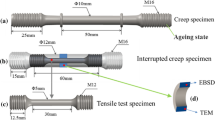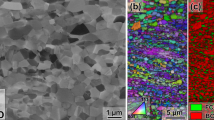Abstract
This study aims to develop a damage map based on microstructure due to high-temperature fatigue load. To start with, Ni–Cr–Mo steel was used. The tensile and fatigue properties of it were investigated. The tests were performed at 750 °C. Microscopic evaluation after deformation revealed a variation of the damage mechanism, which was compared with damage map developed computationally. The dislocation activities that typically were homogeneously distributed at room temperature were localized near grain boundaries at elevated temperatures, similar to that of creep damage. A strong particle-dislocation interaction, usually called interfacial pinning, was observed and hereby mapped. Additional microstructural evolution such as the transformation of structure into coarse equiaxed grains and the carbide coarsening was also observed. A change in fracture mechanism from trans-granular at room temperature to intergranular fracture at elevated temperature similar to creep damage was also verified. The heart of this research was the ability to relate the finite element model that simulates both the equivalent stress and temperature distributions to the real experiment. Based on this estimation, the damage level was developed. Microstructural mapping corresponding to the damage level was subsequently made based on the experiment. It was concluded that the mapping was possible and this research could be thought as the embryo for the better understanding in damage theory bridging metallurgical approach to conventional approach using mesomechanics.








Similar content being viewed by others
References
R. Krivanek, J. Fiedler, Main deficiencies and corrective measures of nuclear power plants in ageing management for safe long term operation. Nucl. Eng. Des. 323, 78–83 (2017)
S.P. Zhu, H.-Z. Huang, L.-P. He, Y. Liu, Z. Wang, A generalized energy-based fatigue–creep damage parameter for life prediction of turbine disk alloys. Eng. Fract. Mech. 90(2012), 89–100 (2012)
J. Oldham, J. Abou-Hanna, numerical investigation of creep-fatigue life prediction utilizing hysteresis energy as a damage parameter. Int. J. Press. Vessels Pip. 88(4), 149–157 (2011)
Z.C. Fan, X.D. Chen, L. Chen, J.L. Jiang, A CDM-based study of fatigue–creep interaction behavior. Int. J. Press. Vessels Pip. 86(9), 628–632 (2009)
Y. Prawoto, Designing steel microstructure based on fracture mechanics approach. Mater. Sci. Eng. A 507, 74–86 (2009)
I.L. May, T.L. da Silveira, S.N. Monteiro. Inspection, damage assessment and failure prevention in petrochemical plant. Int. J. Mater. Product Technol. 3(3–4) 349–358 (1988), NDT E Int. 31, 383 (1998)
H. Dianyin, F. Meng, J. Huawei Liu, R.W. Song, Experimental investigation of fatigue crack growth behavior of GH2036 under combined high and low cycle fatigue. Int. J. Fatigue 85, 1–10 (2016)
G. Wu, J.M. Yang, The mechanical behavior of GLARE laminates for aircraft structures. J. Mater. 57, 72–79 (2005)
M.P. Paulraj, S. Yaacob, M.S. Abdul Majid, M.N.F.M. Kazim, P. Krishnan, Structural steel plate damage detection using non destructive testing, frame energy based statistical features and artificial neural networks. Proc. Eng. 53, 376–386 (2013)
I. Le May, T.L. da Silveira, C.H. Vianna, Criteria for the evaluation of damage and remaining life in reformer furnace tubes. Int. J. Press. Vessel. Pip. 66, 233–241 (1996)
L.J. Carroll, C. Cabet, M.C. Carroll, R.N. Wright, The development of microstructural damage during high temperature creep–fatigue of a nickel alloy. Int. J. Fatigue 47, 115–125 (2013)
G. Chen, Y. Zhang, D.K. Xu, Y.C. Lin, X. Chen, Low cycle fatigue and creep-fatigue interaction behavior of nickel-base superalloy GH4169 at elevated temperature of 650 °C. Mater. Sci. Eng. 655, 175–182 (2016)
R.-Z. Wang, X.-C. Zhang, F. Liu, L.-L. Yao, S.-T. Tu, Fatigue and fracture behaviors of nickel-based forging gh4169 superalloy and optimization of model parameters. Proc. Eng. 130, 1088–1096 (2015)
K. Fujiyama, K. Mori, D. Kaneko, H. Kimachi, T. Saito, R. Ishii, T. Hino, Creep damage assessment of 10Cr-1Mo-1W-VNbN steel forging through EBSD observation. Int. J. Press. Vessels Pip. 86(9), 570–577 (2009)
H. Mughrabi, Microstructural mechanisms of cyclic deformation, fatigue crack initiation and early crack growth. Philos Trans R Soc A Math Phys Eng Sci 373, 20140132 (2015)
T. Lin, A.G. Evans, R.O. Ritchie, A statistical model of brittle fracture by transgranular cleavage. J. Mech. Phys. Solids 34, 477–497 (1986)
S. Holdsworth, Creep-fatigue failure diagnosis. Materials (Basel) 8, 7757–7769 (2015)
O. Cherniavsky, Y. Rebiakov, A. Cherniavsky, Properties of steels and chromium-nickel alloys under low-cycle combined deformation. Int. J. Fatigue 103, 415–418 (2017)
Acknowledgments
The work was performed during the first author’s stay as a visiting professor at the South Ural State University, Russia. The financial support and contribution from the International office of South Ural State University is highly appreciated. The authors would also like to thank Center for Computation and Solid Mechanics of SUSU, Russia.
Author information
Authors and Affiliations
Corresponding author
Rights and permissions
About this article
Cite this article
Prawoto, Y., Suhartono, A., Chernyavsky, A. et al. Microstructural Damage Mapping on Heat-Resistant Steel Due to High-Temperature Fatigue. J Fail. Anal. and Preven. 18, 1616–1624 (2018). https://doi.org/10.1007/s11668-018-0560-z
Received:
Published:
Issue Date:
DOI: https://doi.org/10.1007/s11668-018-0560-z




